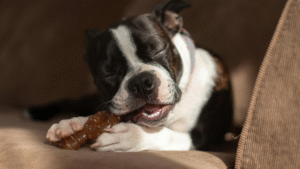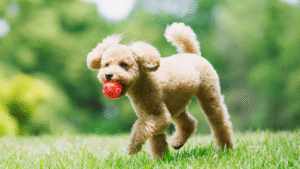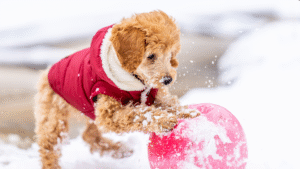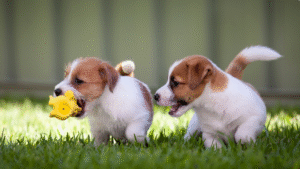Dog training doesn’t always have to focus on obedience, first aid, or basic manners. The internet is full of clever dog tricks that can easily be taught at home, and today we’re going to cover one of the most rewarding ones — teaching your dog to clean up their toys.
Imagine never stepping on a squeaky toy in the middle of the night again, or coming home to find your living room scattered with plushies and chew bones. It might sound like a dream, but surprisingly, dogs can be taught to clean up after themselves — and it’s not even that difficult.

Why Teach Your Dog to Clean Up Their Toys?
Before we get into the actual steps, let’s look at some of the key benefits of teaching this trick.
Mental Stimulation
As any experienced dog owner knows, dogs love mental challenges. When their minds are engaged, they’re calmer, better behaved, and more focused. Teaching your dog to clean up their toys is a fantastic way to provide mental enrichment and keep them sharp.
Better Obedience
Although this is a fun trick, it also reinforces basic commands like fetch, drop it, and leave it. It’s a great way to strengthen your dog’s obedience and impulse control through play.
Confidence
Learning something new gives dogs a big confidence boost. This trick can be especially helpful for shy or anxious dogs, helping them feel more capable and proud of themselves.
Tidier Home
Let’s be honest — a dog that puts their toys away is every pet parent’s dream. Not only does it keep your space neat, but it also teaches your dog responsibility in a fun, engaging way.
Stronger Bond
Training together builds trust and communication between you and your dog. Plus, a dog that cleans up after themselves means fewer arguments and less stress in your daily routine — a win-win for both of you.
Now that you understand why this trick is worth learning, let’s start training!

Step 1: Teach Your Dog to Pick Up a Toy on Command
The first step is teaching your dog to pick up their toy. You’ll use positive reinforcement and a clicker or verbal marker (like “Yes!”) to communicate that they’re doing the right thing.
Materials Needed
-
Your dog’s toy
-
Treats or other rewards
-
A quiet training area
Steps
1. Encourage interaction with the toy.
Place your dog’s toy in front of them and wait for them to sniff or touch it. When they do, immediately mark and reward the behavior. This helps your dog associate touching or picking up the toy with positive outcomes.
2. Add a verbal cue.
Once your dog consistently picks up the toy, introduce a verbal cue like “Take it” or “Pick up.” Say the cue right before they grab the toy and reward them when they do.
3. Practice regularly.
Practice several times a day in short sessions (5–10 minutes). With repetition, your dog will learn to associate your cue with the action of picking up the toy.
Pro Tip: If your dog struggles to grip the toy, try switching it out. Start with soft or rope toys — they’re easier to hold than hard plastic ones. Once your dog understands the concept, you can introduce other types.

Step 2: Teach the “Drop It” Command Over a Basket
Next, you’ll teach your dog to drop their toy into a specific spot — the toy basket.
Materials Needed
-
The toy from Step 1
-
A toy basket or box
-
Treats or rewards
Steps
1. Introduce the basket.
Place your dog’s toy basket in front of them. Let them sniff and explore it so they feel comfortable around it.
2. Combine the two actions.
With your dog holding the toy, hold the basket under their mouth and say “Drop it.” When they release the toy into the basket, mark and reward.
3. Repeat until consistent.
Keep practicing until your dog reliably drops the toy into the basket instead of on the floor or in your hand. Gradually lower the basket to floor level as they improve.
4. Add a cue.
Once your dog regularly drops toys into the basket, introduce a cue like “Put it away.” Say it right before they drop the toy.
Training Tip: If your dog drops the toy before reaching the basket, stay calm and try again. Slowly guide them closer until they make the connection. Patience is key — they’ll get it!
Step 3: Chain the Behaviors Together
Now it’s time to put everything together. Your dog already knows how to pick up a toy and where to drop it — now they’ll learn to connect both actions into one smooth routine.
Steps
1. Set up multiple toys.
Place a few toys around the room to create a real cleanup scenario.
2. Give the full command.
Point to a toy and say “Clean up” or “Put your toys away.” When your dog picks up the toy and drops it into the basket, reward them with praise and a treat.
3. Increase the difficulty.
Gradually increase the distance between the toys and the basket. You can also add new toys to keep things interesting.
4. Fade the treats.
Once your dog understands the behavior, start reducing treat frequency. Replace them with praise, petting, or play. This helps your dog maintain the behavior even without food rewards.
Pro Tip: Make it fun! Turn cleanup time into a game. Cheer your dog on, use a happy tone, and celebrate every success to keep them motivated.

Common Challenges & Solutions
1. My dog won’t pick up the toy.
Try a different toy that’s easier to grab or more interesting. You can also rub a little peanut butter on the toy to make it more appealing.
2. My dog drops the toy too soon.
Move the basket closer to your dog until they understand the behavior. Gradually increase the distance once they’re consistent.
3. My dog loses interest.
Keep training sessions short and upbeat. Always end on a positive note, even if the progress is small.
4. My dog only does it when I have treats.
Start by rewarding every success, then slowly reduce treat use while increasing verbal praise or play. Dogs often maintain learned behaviors when they’re emotionally rewarding or routine-based.
Advanced Tips: Take It Further
Once your dog masters the cleanup routine, you can make it more challenging and fun with these advanced variations:
1. Teach toy names.
Teach your dog the names of specific toys (“ball,” “teddy,” “rope”). Then, you can say, “Put the ball away,” and they’ll know exactly which one to grab.
2. Sort by category.
For advanced dogs, teach them to sort toys into separate bins — for example, soft toys in one and bones in another.
3. Add start and finish cues.
Introduce clear commands like “Start cleaning” and “All done” so your dog knows when to begin and when to stop.
4. Integrate into daily life.
Make cleanup part of your daily routine. Have your dog clean up after playtime, before walks, or before bedtime to reinforce consistency.

Why Positive Reinforcement Works Best
There are many ways to train dogs, but positive reinforcement is the most effective and humane. It focuses on rewarding desired behavior instead of punishing mistakes.
Using positive reinforcement keeps training fun and builds a strong bond of trust between you and your dog. It also helps your dog learn faster and feel more confident about what’s expected of them.
Avoid scolding or showing frustration if your dog doesn’t get it right away. Consistency, patience, and encouragement go much further. Using a clicker or verbal marker helps you stay consistent, even on days when you’re not at your best.
Final Thoughts
Teaching your dog to clean up their toys is an enjoyable and practical way to bond while keeping your home tidy. The process is simple:
-
Teach your dog to pick up a toy.
-
Teach them to drop it into a basket.
-
Chain the two behaviors into a single “clean up” routine.
With patience, consistency, and lots of praise, your dog will soon master this adorable and useful trick. It might take some time, but every minute you invest in training strengthens your relationship and makes life with your dog even more harmonious.
- 5 Cheap Alternatives To Dog Training Equipment - November 12, 2025
- Homemade Calming Spray To Help Dogs During Training - November 12, 2025
- 7 DIY Dog Training Tools You Can Make From Household Items - November 12, 2025
